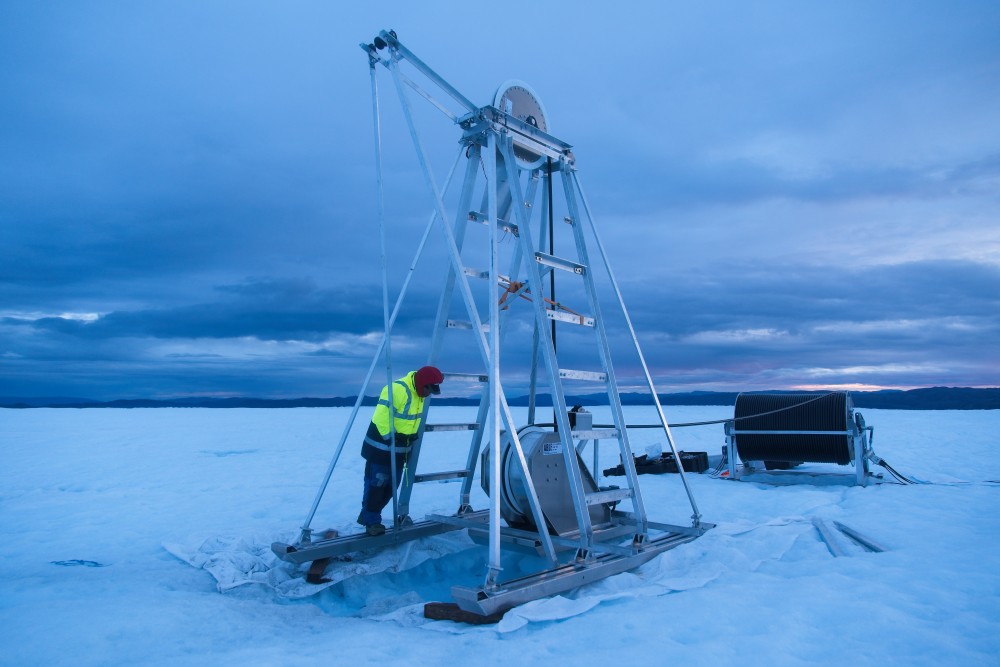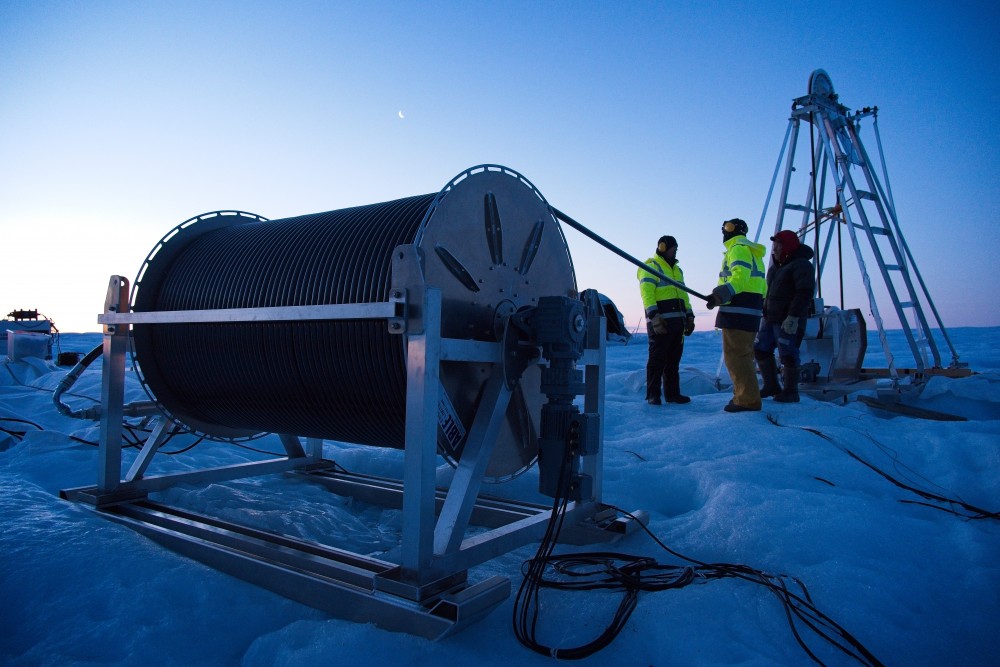
Risky project conducted in Greenland to understand the scale of climate crisis
 It has been another exceptional year for the Earth’s climate system. There doesn’t seem a week when record-breaking floods, wildfires, heatwaves, and sea-ice losses have not grabbed global headlines.
It has been another exceptional year for the Earth’s climate system. There doesn’t seem a week when record-breaking floods, wildfires, heatwaves, and sea-ice losses have not grabbed global headlines.
Yet while debates on the climate crisis have often revolved around the question of carbon dioxide (CO2) emissions, it is methane (CH4) that many see as the key to limiting future warming. This potent greenhouse gas, with its warming potential 84 times greater than that of CO2 over a 20-year period, has so far been responsible for around 30% of the current rise in global temperature.
Worryingly, some scientists believe that large and unaccounted stores of methane are locked up beneath the Greenland and Antarctic ice sheets. As these glaciers continue to melt and retreat, this gas would be released into the atmosphere at accelerating rates, thus creating a vicious amplifying climate feedback.
“The Greenland ice sheet is the biggest contributer to global sea level rise at the moment. And it’s set to accelerate. So we need to understand how fast that is happening. It already looks like it will be a problem for low lying coastal regions around the planet in the next 80 years”, Alun Hubbard - Professor of Glaciology at the Arctic University of Norway told the Barents Observer.

To uncover how much methane is being potentially produced and stored beneath these vulnerable ice sheets, this summer a team of 7 scientists from Norway, Czechia, Brazil, and North America traveled to Greenland to undertake an ambitious and risky project to see what is happening directly at the bed of the ice sheet.
“When glaciers advanced in the past, they buried vegetation and soil, trapping organic carbon beneath the ice. Over time, microbes may have transformed this carbon into greenhouse gases”, expedition member Petra Klimova, microbiologist from Charles University in Prague, told The Barents Observer.
The chosen study site was Isunguata Sermia - a relatively small outlet glacier - but crucially an area where methane has already been found to be leaking from the ice margin.

ADVERTISEMENT
Getting onto the ice
Isunguata Sermia is the only area of the entire ice sheet accessible by road. All the equipment, fuel, and supplies needed for a 3-week science camp could therefore be transported here and then onto the ice by a short helicopter trip. The logistics were not always straightforward though.
“When something went wrong, we had to be creative. For example, when we unexpectedly found that some equipment was several 100 kilograms over the limit for the helicopter carry, we had to find a way to pull it apart and reduce the weight.”, Petra Klimova recollects.
The map below details the route the scientists took from the town of Kangerlussuaq to their camp on the ice sheet.
Reaching for the unknown
To gain access to this hidden environment beneath the ice sheet, the scientists needed to create a borehole - a window through the entire ice column.
“We were trying a new technique which was to use hot water to drill, so that we could reach the bed as quickly as possible. Where previous projects have taken five or six years to get to the base of the ice, instead we wanted to do it in two or three days, and on a much cheaper budget.” professor Alun Hubbard explains.

With the help of a clean hot-water drill - essentially an industrial-scale pressure washer - the drilling team melted their way down from the glacier surface all the way to its base.


Ice sheets are phenomenally large bodies of ice that can reach thicknesses of several kilometres. The hose needed for such an operation therefore had to be very long. The scientists brought 1600 m of it, just on the cusp of what the helicopter could lift.


Heating and pressurizing the purified hot water through this hose also required multiple diesel heaters and pumps weighing up to 400 kg each. Shifting them around the ice sheet by hand without lifting equipment became extremely physically demanding.


Drilling begins
Despite their solid appearance, glaciers deform and flow like honey under their immense weight. Drilling a hole through glacial ice is therefore a constant battle against the creeping physics and freezing temperatures wanting to close it shut again.
“This intense drilling comes with its own problem - the hot water stays in the hole and freezes up very quickly. So we have a very short time window to get our science done in these boreholes,” professor Alun Hubbard explains.
The scientists therefore had to work continuously around the clock to keep the heaters fuelled and ensure the hot water supply into the borehole didn’t stop - any breakdown in the system could have disastrous consequences: the drill equipment could just freeze into the ice and be lost. The microbiologists were working too, collecting water samples from the borehole to monitor any changes in its chemistry during the drilling process.

“The drilling takes 3 continuous days and it’s running round the clock. And if you’re not sleeping and resting well, you’re not so functional after three days. This intense work is also very noisy - six big diesel motors chugging away, producing lots of heat and exhaust, it’s industrial and full on”, professor Alun Hubbard recollects.


After days of non-stop work, and the fuel supply reaching critically low levels, water suddenly drained from the bottom of the borehole. It was the sign the drilling team had been waiting for; they had finally made a successful connection to the ice sheet bed.

At over 1000 metres below their feet, the final ice at the bed of the glacier had been penetrated, allowing the column of water filling the borehole to partially drain away. With the window now open the scientists had roughly 24 hours to recover as many samples of the sediments below as possible, before this roughly 30 cm-wide hole closed again - the race was on!
Collecting samples blind and through a narrow 1 km-long hole is an extremely difficult task. Despite several instruments being deployed down the borehole during the next day, luck was not on the scientist’s side. The borehole had closed shut before anything could be recovered.
Hope not lost
Although the scientists had no samples and very little fuel, what they did have was plenty of time. Their helicopter pickup back to town would not be for another 2 weeks.
With their camp only 6 km from the edge of the ice sheet and civilization, an audacious plan was hatched to pack in the diesel required to reopen the borehole. Over the next week, each member of the team pitched in to carry up to 30 litres of fuel evey day on their backs through the crevassed terrain of the ice-sheet margin.


“I personally was carrying a maximum of 15 litres of diesel, I felt it was the safe amount for me to carry, - Petra Klímová says adding. “I was really amazed that everyone agreed to carry fuel even though no one was forced to do it. I was really touched by such team work.”
“We of course wanted to keep the science alive, but the promise of musk-ox burgers during the occasional trip into town provided good additional motivation and a nice break from the drytech food we were living off in camp”, glaciologist Dr. Henry Patton told The Barents Observer.
While some were hiking with fuel, other scientists set about collecting seismic data to infer more about what lay beneath the ice they were drilling. By sending explosive waves of energy through the ice and precisely measuring their echos off what lay below with an array of geophones, the scientists could retrieve useful information such as how the ice thickness varied and the nature of any sediments below.

“The preliminary seismic data we collected seems to confirm our suspicions that layers of sediment are lying under the ice here - more than 150 metres thick in fact - and importantly the potential envrionment for methane production that we have been on the hunt for”, explained Henry Patton.

The fuel carry was still ongoing, and after 7 days the team had managed to transport on their feet 600 litres of diesel – three full barrels – into camp. This would be just enough to start the heaters again and reopen the 1km-deep borehole.

While the initial progress of the second borehole was good, at just over 400 m down the drill encountered a problem again. This time it encountered a blockage that it could not navigate past. With fuel running low, and with the potential risk of getting the drill permanently stuck or damaged, the decision was made at 3 a.m. to abort and pack up for this season.

Hard lessons learned
The final days were spent transporting all equipment off the ice and removing all traces of the camp. While the scientists did not retrieve the sediment cores from the bed that they had hoped for, the ice drill was successfully tested to over 1 km and many lessons were learned that will be adopted for campaigns over the next few years where the team will access the bed again in Greenland, and ultimately, Antarctica.

After spending three weeks on the ice sheet working under physically and mentally tough working conditions, how do the scientists feel about their field season?
“For me it was a really successful field season, - professor Alun Hubbard said, “I was especially happy with the drill work and how we went about solving problems. The team worked hard and it’s not easy, especially if they haven’t had much experience of it before.”
“During such field work, you get to be in really beautiful places, and probably the first people stepping on that ground ever; I feel privileged to do that. As scientists, we are all fascinated by Greenland ice sheet - it’s enormous, and any changes there could have really important implications for global methane”, microbiologist Petra Klimova concluded.

The drilling team comprised Alun Hubbard, Henry Patton, David Hildes, and Hayden Pearson. Henry and Alun are scientists within iC3 (Centre for ice, Cryosphere, Carbon and Climate) - a newly funded Centre of Excellence in Norway based at UiT The Arctic University of Tromsø.
The microbiologist team, including Petra Klímová, Lia Wentzel, and the group leader Marek Stibal form part of The Cryosphere Ecology Group (@CryEco) at Charles University in Prague.
The Barents Observer Newsletter
After confirming you're a real person, you can write your email below and we include you to the subscription list.



